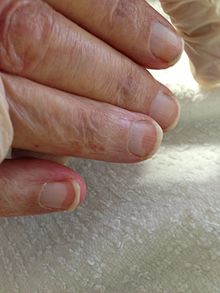Terry's nails

Terry's nails is a physical finding in which fingernails and/or toenails[1]: 659 appear white with a characteristic "ground glass" appearance, with no lunula.[2] The condition is thought to be due to a decrease in vascularity and an increase in connective tissue within the nail bed.[3] It frequently occurs in the setting of liver failure, cirrhosis, diabetes mellitus, congestive heart failure, hyperthyroidism, and/or malnutrition. Eighty percent of patients with severe liver disease have Terry's nails, but they are also found in patients with kidney failure, in patients with congestive heart failure[4] and are described as a brown arc near the ends of the nails.[5] The recognition of characteristic nail patterns, such as Terry’s nails, may be a helpful herald for early diagnosis of systemic diseases.[6]
This was named for Dr. Richard Terry.[7]
See also
References
- ^ Freedberg, et al. (2003). Fitzpatrick's Dermatology in General Medicine. (6th ed.). McGraw-Hill. ISBN 0-07-138076-0.
- ^ "Nail Abnormalities: Clues to Systemic Disease - March 15, 2004 - American Family Physician".
- ^ Rapini, Ronald P.; Bolognia, Jean L.; Jorizzo, Joseph L. (2007). Dermatology: 2-Volume Set. St. Louis: Mosby. p. 1029. ISBN 1-4160-2999-0.
{{cite book}}: CS1 maint: multiple names: authors list (link) - ^ Nia et al. in Am J Med. 2011 Jul;124(7):602-4.
- ^ Examination Medicine. Nicolas J Tally. MacLennan and Petty Pty Ltd. 2003
- ^ Nia et al. Am J Med. 2011 Jul;124(7):602-4. www.cardiovascular-research.org
- ^ "White nails in hepatic cirrhosis." Lancet. 1954;1:756–9.
